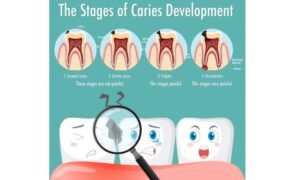Dental cavities are commonly known as tooth decay or caries. It’s a prevalent oral health issue which affects people of all ages. Recognizing a dental cavity is important for oral health. Dental cavities often appear as discolored spots or visible holes on a tooth. Spots color ranges from chalky white to yellow, brown, or black. Understanding “what does a cavity look like?” helps in early detection and enables timely treatment to prevent further dental issues.
What is a Dental Cavity?
A cavity is a hole or structural damage that develops on the surface of a tooth due to prolonged exposure to acids produced by bacteria. It starts as a small spot and gradually progresses into a more significant lesion if left untreated.
Identifying the Appearance of Cavities
Recognizing cavities involves understanding their visual characteristics and where they typically occur. Here’s what cavities look like:
1. Color Changes:
-
- Initially, cavities may appear as white spots or chalky areas on the tooth surface.
- As decay progresses, the color changes to yellow, brown, or black, indicating deeper damage.
- Severe cases might show visible holes or pits in the tooth.
2. Texture and Sensation:
-
- The affected area might feel rough or have a sticky texture when touched with the tongue or fingers.
- Sensitivity to hot, cold, sweet, or sour foods can be a sign of a cavity.
3. Location:
-
- Cavities often occur in hard-to-reach areas, such as between teeth, along the gum line, or on biting surfaces.
- They can also develop around existing dental fillings or near the edges of crowns or dental appliances.
What are Different Types of Cavities?
Understanding the various types of cavities helps in identifying their distinct appearances and locations within the mouth.
1. Pit and Fissure Cavities:
-
- These cavities occur in the grooves and fissures on the chewing surfaces of molars and premolars.
- They often appear as small, dark spots or lines and can be challenging to clean with regular brushing.
2. Smooth Surface Cavities:
-
- These cavities form on flat surfaces between teeth or along the gumline.
- Initially, they may present as white or brown spots and progress to visible holes if untreated.
3. Root Cavities:
-
- Root cavities develop on the roots of teeth. They are more common in older adults with receding gums.
- They usually appear near the gum line and exhibit a yellowish-brown discoloration.
4. Recurrent or Secondary Cavities:
-
- These cavities occur around existing fillings, crowns, or other dental restorations.
- They may appear as dark areas adjacent to the dental work, indicating a need for repair or replacement.
What Does a Cavity Look Like when it First Starts?
Recognizing the initial signs of a cavity is vital for early intervention and prevention of further decay:
- In its early stages, a cavity may manifest as a white spot on the tooth surface, indicating demineralization of the enamel.
- The affected area might feel rough and slightly softer than the surrounding tooth structure.
- As the decay progresses, the spot may change color, becoming yellow or brown, signifying deeper damage to the tooth.
Diagnosis and Examination of Cavities:
Dentists employ various methods to diagnose cavities during routine dental check-ups:
- Visual Examination:
- Dentists visually inspect teeth using mirrors and dental instruments to detect signs of decay.
- They look for discoloration, roughness, or visible holes on tooth surfaces.
- X-rays (Radiographs):
- X-rays help identify cavities between teeth or under existing fillings that are not visible to the naked eye.
- They provide a detailed view of the extent and location of decay within the tooth structure.
- Laser Fluorescence:
- Advanced dental tools use laser fluorescence to detect early signs of decay before they become visible or cause symptoms.
- This technology aids in identifying cavities at their initial stages, allowing for minimally invasive treatment.
What Does a Cavity Look Like on an X-ray?
X-rays play a crucial role in diagnosing cavities, especially those not visible during a regular examination:
- On an X-ray, cavities appear as dark areas or shadows within the tooth structure.
- They can detect cavities between teeth or under existing fillings, showing the extent and location of the decay.
- X-rays assist dentists in identifying cavities in their early stages, facilitating timely intervention and treatment planning.
How to Prevent Dental Cavities?
Dental cavities can be prevented by adopting good oral hygiene practices and making lifestyle choices that promote dental health. Here are key strategies to prevent cavities:
1. Regular Dental Hygiene:
-
- Brush your teeth at least twice a day using fluoride toothpaste. Ensure thorough cleaning of all tooth surfaces.
- Floss daily to remove plaque and food particles from between teeth where toothbrushes can’t reach.
2. Balanced Diet:
-
- Limit the consumption of sugary and acidic foods and drinks. Opt for healthier alternatives and drink plenty of water.
- Avoid frequent snacking, especially on sugary items, as it can contribute to cavity formation.
3. Fluoride Use:
-
- Use fluoride toothpaste and mouth rinses as recommended by dentists to strengthen enamel and prevent decay.
- Consider fluoride treatments or dental sealants, especially for individuals at higher risk of cavities.
4. Regular Dental Check-ups:
-
- Schedule routine dental visits for professional cleanings and thorough examinations.
- Early detection and preventive measures by a dentist can halt the progression of cavities.
5. Lifestyle Choices:
-
- Avoid smoking and tobacco use, which can contribute to gum disease and tooth decay.
- Chew sugar-free gum containing xylitol, which may help reduce bacteria and promote saliva production.
Treatment of Dental Cavities
Dental treatment aims to restore affected teeth and prevent further decay. Treatment options depend on the severity of the cavity:
1. Dental Fillings:
-
- Dentists remove decayed portions of the tooth and fill the space with materials like amalgam, composite resin, or glass ionomer.
- Fillings restore the tooth’s function, prevent decay progression, and improve aesthetics.
2. Dental Crowns:
-
- For extensive decay that weakens the tooth, a dental crown, usually made of porcelain or metal, is placed to cover and protect the remaining tooth structure.
- Crowns restore the tooth’s shape, strength, and functionality.
3. Root Canal Therapy:
-
- When decay reaches the tooth’s pulp, causing infection and pain, root canal therapy is necessary.
- This procedure involves removing infected tissue, disinfecting the root canal, and sealing it to prevent further damage.
4. Fluoride Treatments and Sealants:
-
- Dentists may apply fluoride directly to the teeth to strengthen enamel and prevent decay.
- Dental sealants, a thin protective coating applied to the chewing surfaces of back teeth, act as a barrier against bacteria and acid.
Can You Reverse a Cavity?
In some cases, early-stage cavities may be reversed or halted through preventive measures:
- Remineralization can occur when the early signs of decay are addressed promptly.
- Fluoride treatments, using fluoride toothpaste or mouth rinses, can aid in strengthening enamel and reversing early decay.
- Adopting good oral hygiene practices, such as brushing with fluoride toothpaste and reducing sugar intake, can prevent cavity progression.
When to See a Dentist?
You should consult a dentist in case of following symptoms:
- Persistent toothache or sensitivity, especially with hot, cold, sweet, or sour foods
- Visible discoloration, dark spots, or chalky areas on teeth
- Discomfort or pain while eating or drinking
- Swollen, red, or bleeding gums around a tooth
- Persistent bad breath or unpleasant taste in the mouth
- Loose, chipped, or fractured fillings
- Regular dental check-ups every six months, regardless of symptoms
FAQ’s
- How does a cavity look like?
Cavities may appear as discolored spots or holes on the tooth surface, ranging from white, yellow, brown, to black, indicating decay.
- How do you know you have a cavity?
You might experience tooth sensitivity, pain, visible holes, or discoloration on your teeth, signaling the presence of a cavity.
- What does a small cavity look like?
A small cavity might manifest as a white or brown spot on the tooth surface, potentially rough to touch, indicating initial decay.
- When you have a cavity what does the dentist do?
Dentists typically remove the decayed part of the tooth and fill the space with a filling material to restore the tooth’s structure and function.
- What does a cavity look like between teeth?
Cavities between teeth may not be visible externally but can cause slight discoloration, floss tearing, or sensitivity in the affected area. An X-ray helps in diagnosis.
For any further query about this condition feel free to contact us at https://medicalinquiries.com/contact-us/
Bottom Line
Recognizing what does a cavity look like is really important for keeping your mouth healthy. Finding cavities early and getting treatment quickly stops them from getting worse. Going to the dentist often and taking good care of your teeth are super important to stop cavities. Remember, keep your teeth clean and visit the dentist regularly to keep your mouth healthy and happy.
Disclaimer
Content on this site is written with thorough research and keeping in mind the latest guidelines. However, no content on this site should substitute professional consultation.
